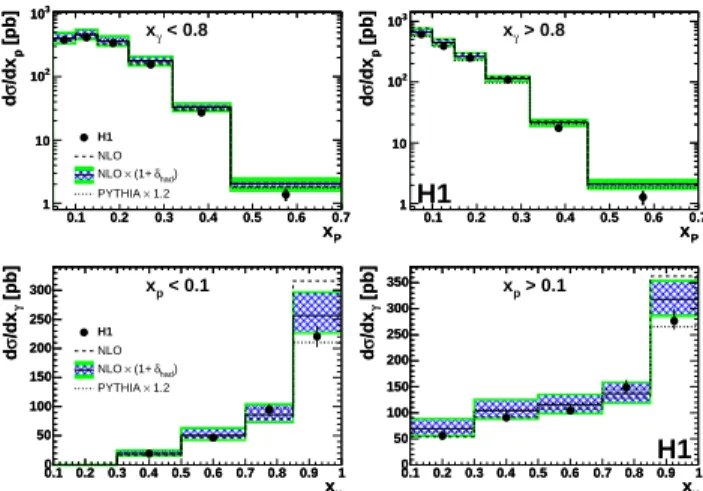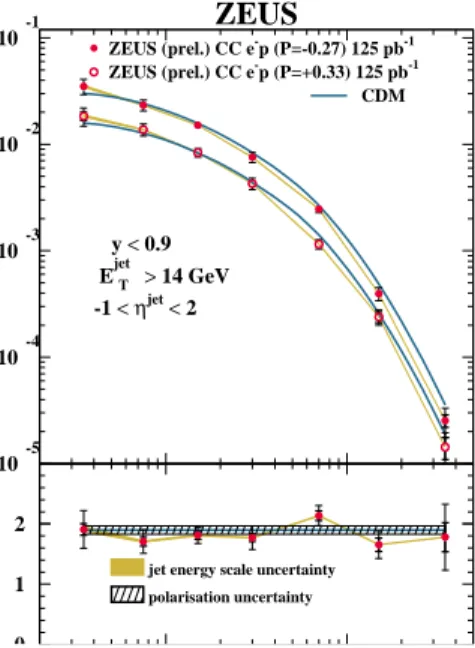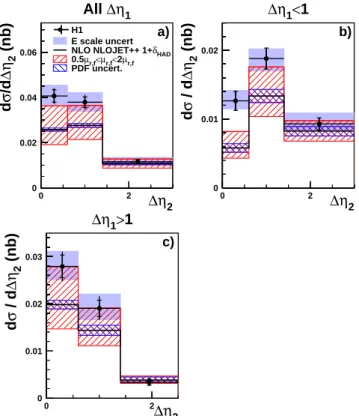846 Brazilian Journal of Physics, vol. 37, no. 2C, June, 2007
Jet Physics in
ep
Collisions
Valentin Efremenko, on behalf of the H1 and ZEUS collaborations
Institute for Theoretical and Experimental Physics, Moscow, Russia
Received on 01 November, 2006; Revised on 30 January, 2007
The most recent results of jet cross section measurements at HERA collider in photoproduction and deep inelastic scattering are presented. The forward jet and multiple jet productions are discussed from point of view of QCD dynamics. Results of precise extractions of the strong couplingαsare presented.
Keywords: Jet physic; QCD hard interactions
During the last years a noticeable progress has been achieved in measuring and understanding of jet production at high energies. H1 and ZEUS are two multipurpose ex-periments, which are well suited for study of jet physics. Both experiments located in North and South halls of the HERA electron-proton collider in Hamburg, Germany, solve the same problem using different methods.
Both experiments are designed using in principle the same lay-out. The interaction vertex is determined with central tracking detectors, which are surrounded by electromagnetic and hadronic calorimeters. The luminosity is measured from the rate of the bremsstrahlung processep→epγ. Detail de-scriptions of the detectors can be found in [1, 2].
I. PHOTOPRODUCTION OF DI-JETS
The largest cross section at HERA collider is due to photo-production process with the momentum transfer squared,Q2, almost equal to zero. Nevertheless, the photoproduction of di-jets with high transverse momenta can be calculated within perturbative Quantum Chromo Dynamic (QCD) where the transverse momentum of jets provides the hard scale.
The measured cross section of di-jet events in the photopro-duction as a function of variablesxpandxγis shown in Fig. 1
[3]. In the leading orderxpandxγare the longitudinal photon
and proton momentum fractions entering the hard interaction. The transverse energy of the first jet is more than 25 GeV and the transverse energy of the second jet is more than 15 GeV.
Two top histograms are presented for the resolved en-riched events(xγ<0.8), when the photon interacts through its
hadronic contents, and for thedirectevents (xγ>0.8), when
photon interacts as a point-like particle.
Two bottom histograms are from two subsamples of events forxp<0.1 andxp>0.1. For smallxp, about 70% of events are induced by gluons. This means that these two subsam-ples of events roughly distinguish between photon-gluon fu-sion (xp<0.1) and photon-quark scattering (xp>0.1).
The next to leading order (NLO) QCD calculation and the PYTHIA Monte Carlo (MC) calculation provide a reasonable descriptions of the data. These data, combined with inclusive deep inelastic scattering (DIS) cross section measurements, help to extract proton parton density function (PDF) with im-proved precision.
P
x
0.1 0.2 0.3 0.4 0.5 0.6 0.7
[pb]
p
/dx
σ
d
1 10
2
10
3
10
P
x
0.1 0.2 0.3 0.4 0.5 0.6 0.7
[pb]
p
/dx
σ
d
1 10
2
10
3
10
< 0.8
γ
x
H1
NLO )
had δ
(1+
×
NLO 1.2
×
PYTHIA
P
x
0.1 0.2 0.3 0.4 0.5 0.6 0.7
[pb]
p
/dx
σ
d
1 10
2
10
3
10
P
x
0.1 0.2 0.3 0.4 0.5 0.6 0.7
[pb]
p
/dx
σ
d
1 10
2
10
3
10
> 0.8
γ
x
H1
γ
x
0.1 0.2 0.3 0.4 0.5 0.6 0.7 0.8 0.9 1 [pb]γ
/dx
σ
d
0 50 100 150 200 250 300
γ
x
0.1 0.2 0.3 0.4 0.5 0.6 0.7 0.8 0.9 1 [pb]γ
/dx
σ
d
0 50 100 150 200 250
300 xp < 0.1 H1
NLO )
had δ
(1+
×
NLO 1.2
×
PYTHIA
γ
x
0.1 0.2 0.3 0.4 0.5 0.6 0.7 0.8 0.9 1 [pb]γ
/dx
σ
d
0 50 100 150 200 250 300 350
γ
x
0.1 0.2 0.3 0.4 0.5 0.6 0.7 0.8 0.9 1 [pb]γ
/dx
σ
d
0 50 100 150 200 250 300
350 > 0.1
p
x
H1
FIG. 1: Cross section as a function ofxγ(for two regions inxp) and xp (for two regions inxγ) for data (points), NLO QCD predictions with (solid line) and without (dashed line) hadronisation corrections and for PYTHIA Monte Carlo predictions (dotted line). The hatched and shaded bands for NLOx(1+δhad)result in the scale and the total uncertainties respectively.
II. JETS IN DIS
Currently the perturbative calculations in QCD for values of the four momentum transfer squared,Q2, larger than a few GeV2are very reliable. The inclusive jet and di-jet analysis allows to constrain the gluon density in the proton, to extract the proton PDF, to extract value ofαs[4].
Due to good understanding of the detectors, H1 and ZEUS collaborations have measured inclusive jet and di-jet cross sections with high accuracy. Fig. 2 shows the cross section of di-jet production in DIS process as a function ofQ2 sured by ZEUS Collaboration. Di-jet cross section was mea-sured with high precision in the kinematic region 125<Q2< 5000GeV2[5]. The figure also includes the NLO QCD cal-culations with renormalisation scaleµ2R=Q2+E2T,µ2R=Q2 andµ2R=E2T. The lower part of the figure shows the relative differences of the data with respect to NLO QCD calculations. The largest contributions to systematic uncertainty come from uncertainty in absolute energy scale(±10%)and the correc-tion factor for detector effects (±8%). The largest contribu-tion to theoretical uncertainties(±20%)comes fromµR. The theoretical uncertainties are dominated.
Valentin Efremenko 847
)
2
(pb/GeV
2
/dQ
σ
d
-3
10
-2
10
-1
10
) 2 (GeV 2 Q
200 300 1000 2000
rel. diff. to NLO -0.5 0 0.5
) dijets
-1
ZEUS (82 pb NLO (CTEQ6)
2 T
E +
2
= Q
2 R
µ
2
= Q
2 R
µ
2 T
E =
2 R
µ
jet energy scale uncertainty NLO uncertainty
FIG. 2: The differential cross sections for di-jet production as a func-tion ofQ2. The predictions of NLO QCD with different renormalisa-tion scales are shown. The lower part of the figure shows the relative differences with respect to LO QCD calculations.
and three-jet production and reliable NLO calculations have allowed to extract the strong coupling constant αs with the highest accuracy using different methods. The average ex-tracted values ofαsat the Z-boson mass are
from H1: αs(MZ) =0.1197±0.0016(exp)±0.0047(th); from ZEUS:αs(MZ) =0.1196±0.0025(exp)±0.0023(th). The world average value:αs(MZ) =0.1187±0.0020(exp).
III. JETS IN CHARGE CURRENT REACTIONS
Since 2003 HERA collider operates with a longitudinally polarised lepton beams. The measurements of deep inelas-tic scattering with polarised lepton beams allow the parton distribution functions of the proton to be further constrained through polarisation asymmetries and specific tests of the electroweak part of the Standard Model to be performed. H1 and ZEUS collaborations have measured for the first time total and differential inclusive jet cross sections of the interaction of positrons and electrons with protons in charge current (CC) DIS reactions with polarised beams.
Figure 3 shows the CC negatively and positively polarised e−pDIS inclusive jet differential cross sections as a function ofQ2[6]. The value of cross sections are changed by three order, but the behaviour of cross section shows a less rapid fall-off than what is observed in neutral current DIS processes due to the massive W propagator. For comparison, the pre-dictions of the leading-logarithm parton shower MC Colour-Dipole Model is included in the figure. In the lower part of the figure the ratio of the cross sections for negatively and posi-tively polarised electron beams is shown. It is in agreement with the measured polarisation ratio,(1−Pneg)/(1−Ppos) =
1.90±0.07. The total jet cross sections in the studied
kine-ZEUS
10-5 10-4 10-3 10-2
10-1 ZEUS (prel.) CC e
-p (P=-0.27) 125 -pb-1
ZEUS (prel.) CC e-p (P=+0.33) 125 pb-1
CDM
y < 0.9 EjetT > 14 GeV
-1 <ηjet< 2
jet energy scale uncertainty polarisation uncertainty
0 1 2
FIG. 3: The differential cross sections for CC inclusive jet events as a function ofQ2for negative and positive polarised electron beams. The predictions of CDM model are included. The lower part of the picture displays the ratio of the cross sections for negatively and pos-itive polarised electron beams.
matic region are in agreement with the MC predictions.
IV. FORWARD JETS
QCD calculations based on DGLAP evolution scheme are successful in describing strong rise ofF2(xB j,Q2) with de-creasing Bjorken scaling variablexB j over a largeQ2range. DGLAP scheme resums leading log(Q2) terms and implies strong ordering of the transverse momenta of the emitted par-tonskt.
Are there regions with a different parton dynamics? The DGLAP approximation may become inadequate for smallxB j, where log(1/x)terms become important in the evo-lution equation. Significant deviations from the LO DGLAP approach are observed in the forward jet production, trans-verse energy flow, fractional rate of di-jet production. Other approaches, like the BFKL, suggest different parton dynam-ics, which can be responsible for the observed deviation.
Let us consider a sample of events with a forward jet with pseudorapidity ηf wd jet >1.7 and two additional jets with pseudorapidities ηjet1 andηjet2 respectively. For ηf w jet >
ηjet2>ηjet1the differences between the pseudorapidities are ∆η1=ηjet2−ηjet1and∆η2=ηf w jet−ηjet2.
In Fig. 4, the cross section for this sample of events as a function of∆η2is shown for∆η1<1, for∆η1>1 and for the
total sample [7]. The result of NLO calculation from NLO-JET++ with hadronic correction is also shown with theoretical error included as bands.
848 Brazilian Journal of Physics, vol. 37, no. 2C, June, 2007
H1 E scale uncert NLO NLOJET++ 1+δHAD 0.5µr,f<µr,f<2µr,f PDF uncert.
∆η2
d
σ
/d
∆η
2
(nb)
All ∆η1 a)
0 0.02 0.04 0.06
0 2 ∆η
2
d
σ
/ d
∆η
2
(nb)
∆η1<1
b)
0 0.01 0.02
0 2
∆η2
d
σ
/ d
∆η
2
(nb)
∆η1>1
c)
0 0.01 0.02 0.03
0 2
FIG. 4: The cross section for events with di-jet and forward jet as a function of the rapidity separation between the forward jet and the most forward-going additional jet. The data are compared to the pre-dictions of NLOJET++.
102 103 104 105
10−4 10−3
Data 99/00
O(αs3)
O(αs2)
xBj
d
σ
/dx
Bj
[
pb
]
Parton Level
H1 preliminary
102 103 104 105 106
10−4 10−3
Data 99/00 CDM RG d+r H1 preliminary
xBj
d
σ
/dx
Bj
[
pb
]
FIG. 5: Experimental (dots) differential cross sections as a function of the Bjorken scaling variablexB jfor events with two forward jets. Data are compared to the LO(α2
s)and NLO(α3s)QCD calculations (left picture) and to the predictions of CDM and RAPGAP with re-solved photon (right picture).
the data are in agreement with NLOJET++ prediction. If the
additional hard jets are shifted to the forward region and∆η2
decreases, the agreement is not as strong. If both additional jets are in the forward region,∆η1and∆η2are small and with
higher probability, all three jets are produced from gluon ra-diation. Because all three jets have transverse momenta larger than 6 GeV (selection criteria) the strongkt ordering which is important for DGLAP evolution, does not work and NLO-JET++ prediction is much lower in comparison to the experi-mental data.
In Fig. 5 (left) the cross section of event production with two jets in the forward region as function ofxB jis shown. The data are compared to the calculations predicted by LO(α2
s) and NLO(α3
s)QCD. The LO prediction does not describe the experimental data. Main discrepancy is seen at lowxB j. The prediction of NLO(α3
s)QCD is much better, however more than 30% of events are still missing.
In the Colour Dipole Model, partons are generated by colour dipoles. Since the dipoles radiate independently there is no ordering in the transverse momenta of the emissions, which is similar to the BFKL approach. The RAPGAP MC program uses LO matrix element supplemented with initial and final state parton showers generated according to the DGLAP evolution. However in case ofresolvedprocess the photon interacts with proton through its hadron structure. This means that two evolution ladders are introduced, one from photon side and one from proton side and the strong k t-ordering does not exist.
In Fig. 5(right) the cross section as function of xB j is shown for DIS production of three-jet events with two jets in the forward region.The experimental data are compared to LO Monte Carlo program DJANGO with Colour Dipole Model (CDM) and RAPGAP with resolved photon contribu-tion. In both programs nonkt-ordering gluon radiation is im-plemented. The agreement with experimental data is remark-able.
V. CONCLUSION
Considerable progress in measurements and understanding of jet production is achieved at HERA as well as in theoretical calculations and reliable predictions. The good understanding of pQCD and precise measurements of the cross sections have allowed to extract one of the important parameters of theory
αswith an excellent accuracy. In some regions, however, the-oretical uncertainties are dominated by scale variation effects.
[1] H1 Collaboration, I. Abtet al., Nucl. Instrum. Meth. A386, 310, 348 (1997).
[2] U. Holm (ed.)The ZEUS Detector, DESY (1993), available on http://www-zeus.desy.de/bluebook/bluebook.html
[3] H1 Collaboration, A. Aktaset al.Phys. Lett. B639, 21 (2006). [4] C. Glasman, hep-ex/0506035 (2005).
[5] ZEUS Collaboration, S. Chekanovet al.Preprint DESY-06-128,
DESY, 2006.
[6] ZEUS Collaboration, ZEUS-prel-06-002, ICHEP06 (2006), Moscow, Russia, avalable on http://www-zeus.desy.de/physics/ phch/conf/ichep06/


